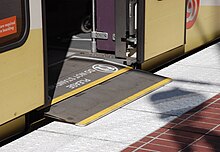Siemens SD660
| Siemens SD660 (Types 2 and 3) | |
|---|---|
 A train of SD660s on the Steel Bridge in Portland, Oregon | |
 Interior of an SD660 | |
| Manufacturer | Siemens |
| Built at | Sacramento, California |
| Constructed | 1996–2005 |
| Entered service | 1997 |
| Number built | 79 |
| Number in service | 79 |
| Successor | Siemens S70/S700 |
| Fleet numbers | Type 2: 201–252 Type 3: 301–327 |
| Operator(s) | TriMet |
| Specifications | |
| Car length | 91.93 ft (28.02 m) over couplers |
| Width | 8.71 ft (2.65 m) |
| Height | 13 ft (4.0 m) |
| Floor height | High floor section: 3.22 ft (980 mm) Low floor section: 1.18 ft (360 mm) |
| Low-floor | 70% |
| Entry | Level |
| Doors | 8 per car (4 per side) |
| Articulated sections | 3 |
| Wheelbase | 5.90 ft (1,800 mm) |
| Maximum speed | 55 mph (89 km/h) |
| Weight | 108,000 lb (49 t) |
| Traction system | IGBT–VVVF (Siemens)[1] |
| Traction motors | 4 × Siemens 175 kW (235 hp) 3-phase AC induction motor |
| Power output | 700 kW (940 hp) |
| Acceleration | 3 mph/s (1.3 m/s2) |
| Deceleration | 3 mph/s (1.3 m/s2) (service) 5 mph/s (2.2 m/s2) (emergency) |
| Electric system(s) | 750 V DC from overhead catenary |
| Current collector(s) | Pantograph |
| Minimum turning radius | 82.02 ft (25.00 m) (horizontal) 820 ft (250 m) (crest vertical) 1,150 ft (350 m) (sag vertical) |
| Coupling system | Scharfenberg |
| Multiple working | Within type With Bombardier Type 1[2][3] |
| Track gauge | 4 ft 8+1⁄2 in (1,435 mm) standard gauge |
The Siemens SD660, originally known as the Siemens SD600,[4] is a double-articulated, 70%-low-floor light rail vehicle (LRV) manufactured by Siemens Transportation Systems. It was the first low-floor light rail vehicle to be used in the United States.[5][6] It first entered service in 1997 with its only operator, TriMet, on the MAX light rail system in Portland, Oregon, United States.
History[]
The initial order placed by TriMet in May 1993 was for 39 cars. It was the first order for low-floor light rail vehicles (LRVs) in North America.[5] The order was subsequently expanded to 46 cars and ultimately to 52.[7] TriMet received the first car, which it numbered 201, in July 1996,[8][9] and the first nine cars entered service on August 31, 1997.[2][3] Siemens retroactively changed the car's model designation from SD600 to SD660, a change relating to its use of AC motors running on 60 Hz instead of DC ones, in 1998.[4] The 52nd car was received by TriMet in April 2000.[10]
TriMet later purchased 27 more SD660s (initially 17 cars, with another 10 added to the order in 2002),[11] which were built between 2003 and 2005. TriMet designated these "Type 3" in its fleet and numbered them 301–327. The last car was delivered in March 2005.[12]
All 79 SD660 cars were originally equipped with rollsign-type destination signs. TriMet replaced the original signs with LED-type signs in a two-year conversion program that lasted from fall 2014[13] to August 2016.[14]
Features[]

- Bridgeplate wheelchair ramps. These are located at two of the four doorways on each side of an LRV, the two closest to the car's center.[5]
- Bi-directional (or "double-ended"), with operating cabs at both ends[5]
References[]
- ^ "SD660 Light Rail Vehicle Technical Information" (PDF). Siemens Transportation Systems. May 15, 2005. Archived from the original (PDF) on August 9, 2007.
- ^ a b "World News Review". Light Rail & Modern Tramway. No. 718. UK: Ian Allan Publishing/Light Rail Transit Association. October 1997. p. 395. ISSN 0964-9255.
- ^ a b O'Keefe, Mark (September 1, 1997). "New MAX cars smooth the way for wheelchairs". The Oregonian. p. B12.
- ^ a b "Systems News". Tramways & Urban Transit. UK: Ian Allan Publishing/Light Rail Transit Association. October 1998. p. 397. ISSN 1460-8324.
- ^ a b c d Vantuono, William C. (July 1993). "Tri-Met goes low-floor: Portland's Tri-Met has broken new ground with a procurement of low-floor light rail vehicles. The cars will be North America's first low-floor LRVs". Railway Age. pp. 49–51. ISSN 0033-8826.
- ^ "LA And Portland Get New-Design LRVs". International Railway Journal. October 1993. pp. 26–27. ISSN 0744-5326.
- ^ Oliver, Gordon (September 26, 1997). "Tri-Met expands light-rail car order". The Oregonian. p. B6.
- ^ Oliver, Gordon (August 1, 1996). "MAX takes keys to cool new model". The Oregonian. p. D1.
- ^ Wolinsky, Julian (Winter 1998). "Block Signals [regular news section]". The New Electric Railway Journal. No. 38. p. 11. ISSN 1048-3845.
- ^ "Systems News". Tramways & Urban Transit. No. 750. UK: Ian Allan Publishing/Light Rail Transit Association. June 2000. p. 227. ISSN 1460-8324.
- ^ "Systems News". Tramways & Urban Transit. No. 776. UK: Ian Allan Publishing/Light Rail Transit Association. August 2002. p. 308. ISSN 1460-8324.
- ^ "Systems News". Tramways & Urban Transit. No. 809. UK: Ian Allan Publishing/Light Rail Transit Association. May 2005. p. 196. ISSN 1460-8324.
- ^ "Worldwide Review". Tramways & Urban Transit, March 2015, p. 121. UK: LRTA Publishing.
- ^ "Worldwide Review". Tramways & Urban Transit, November 2016, p. 440. UK: LRTA Publishing.
External links[]
![]() Media related to Siemens SD660 at Wikimedia Commons
Media related to Siemens SD660 at Wikimedia Commons
- Light rail vehicles
- Siemens tram vehicles
- Electric multiple units of the United States
- MAX Light Rail
- Train-related introductions in 1996
- 750 V DC multiple units